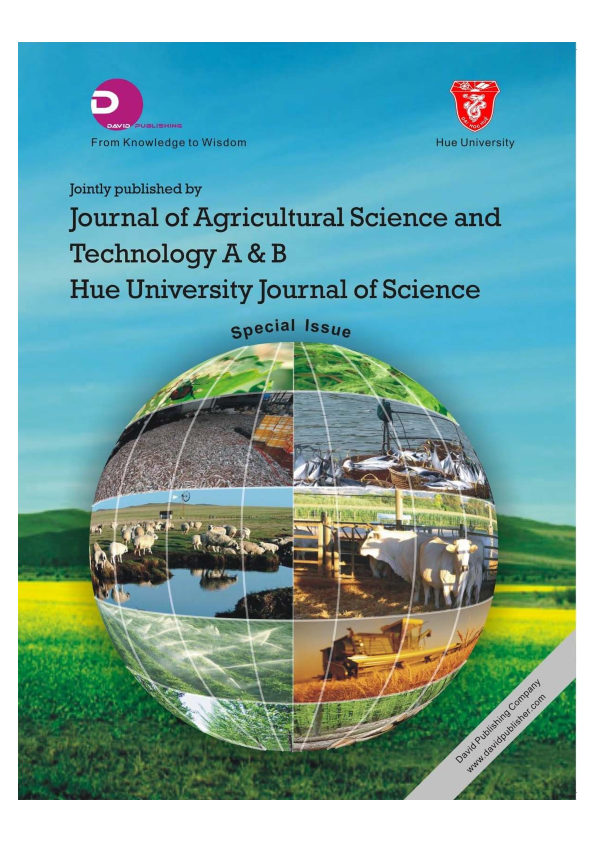Nutrient Mass Balances in Intensive Shrimp Ponds with a Sludge Removal Regime: A Case Study in the Tam Giang Lagoon, Central Vietnam
Abstract
Understanding the sources and sinks of nutrients is of significant importance for better management of pond water quality and the environmental impact of aquaculture. The objective of the present study was to estimate the nutrient mass balances of four intensive shrimp (Litopenaeus vannamei) ponds in Tam Giang Lagoon, Central Vietnam, using a sludge management regime. The nutrient budgets were calculated based on the sources and sinks of nutrients in the ponds over a period of 49 d. The input sources of N and P were mainly shrimp feed, which accounted for more than 90%. Shrimp harvesting was the largest sink of N (37.5%), but not of P (18.3%). Almost a 30.4% N and 16.9% P of input were not accounted for the measured losses. While the smallest proportion of N (18.9%) was retained in sludge, the largest amount of P was accumulated in sludge (53.2%). The farm was operated without water exchange, so ponds gained only 1.9% N and 4.2% P from water intake. The pond lost about 13.2% N and 11.6% P from discharge water. Production of 1 kg shrimp needed 84.9 g N and 26.1 g P from total input sources and discharged 47.3 g N and 16.0 g P to the environment. Environmental losses of nutrients were lower or intermediate, when the loads were expressed in both kg/ha/cycle and kg of N or P per ton of shrimp produced. Furthermore, the environmental impacts of aquaculture are controlled from the system.
Key words: Shrimp pond, L. vannamei, nutrient mass balances, N, P.
References
Páez-Osuna, F., Guerrero-Galván, S. R., Ruiz-Fernández, A. C., and Espinoza-Angulo, R. 1997. “Fluxes and Mass Balances of Nutrients in a Semi-Intensive Shrimp Farm in north-Western Mexico.” Marine Pollution Bulletin 34 (5): 290-7.
Velasco, M., Lawrence, A. L., and Castille, F. L. 1999. “Effect of Variations in Daily Feeding Frequency and Ration Size on Growth of Shrimp, Litopenaeus vannamei (Boone), in Zero-Water Exchange Culture Tanks.” Aquaculture 179 (1-4): 141-8.
Pillay, T. V. R. 2004. Aquaculture and the Environment, 2nd ed. Oxford, UK: Blackwell Publishing Ltd.
Ma, Z., Song, X., Wan, R., and Gao, L. 2013. “A modified water quality index for intensive shrimp ponds of Litopenaeus vannamei.” Ecological Indicators 24: 287-93.
Food and Agriculture Organization of the United Nations (FAO). 1986. Shrimp Culture: Pond Design, Operation and Management. NACA Training Manual Series No. 2, Aquaculture Department, Southeast Asian Fisheries Development Center.
IUCN and IISD. 2003 Expanding Shrimp Aquaculture on Sandy Land in Vietnam: Challenges and Opportunities. Hanoi: IUCN and IISD.
Jackson, C., Preston, N., Thompson, P.J., and Burford, M. 2003. “Nitrogen Budget and Effluent Nitrogen Components at an Intensive Shrimp Farm.” Aquaculture 218 (1-4): 397-411.
Casillas-Hernández, R., Magallón-Barajas, F., Portillo-Clarck, G., and Páez-Osuna, F. 2006 “Nutrient Mass Balances in Semi-Intensive Shrimp Ponds from Sonora, Mexico Using Two Feeding Strategies: Trays and Mechanical Dispersal.” Aquaculture 258 (1-4): 289-98.
Hopkins, J. S., Sandifer, P. A., and Browdy, C. L. 1994 “Sludge Management in Intensive Pond Culture of Shrimp: Effect of Management Regime on Water Quality, Sludge Characteristics, Nitrogen Extinction and Shrimp Production.” Aquacultural Engineering 13 (1): 11-30.
Teichert-Coddington, D. R., Martinez, D., and Ramı́rez, E. 2000. “Partial Nutrient Budgets for Semi-Intensive Shrimp Farms in Honduras.” Aquaculture 190 (1-2): 139-54.
Islam, S., M., Sarker, J., Yamamoto, T., Wahab, A., and Tanaka, M. 2004. “Water and Sediment Quality, Partial Mass Budget and Effluent N Loading in Coastal Brackishwater Shrimp Farms in Bangladesh.” Marine Pollution Bulletin 48 (5-6): 471-85.
Wahab, M. A., Bergheim, A., and Braaten, B. 2003. “Water Quality and Partial Mass Budget in Extensive Shrimp Ponds in Bangladesh.” Aquaculture 218 (1-4): 413-23.
Mariscal-Lagarda, M. M., and Páez-Osuna, F. 2014. “Mass Balances of Nitrogen and Phosphorus in an Integrated Culture of Shrimp (Litopenaeus vannamei) and Tomato (Lycopersicon esculentum Mill) with Low Salinity Groundwater: A Short Communication.” Aquacultural Engineering 58: 107-12.
Frignani, M., Piazza, R., Bellucci, L. G., Cu, N. H., Zangrando, R., Albertazzi, S., Moret, I., Romano, S., and Gambaro, A. 2007. “Polychlorinated Biphenyls in Sediments of the Tam Giang-Cau Hai Lagoon, Central Vietnam.” Chemosphere 67 (9): 1786-93.
Hung, L. T., and Quy, O. M. 2013. On-Farm Feeding and Feed Management in Whiteleg Shrimp (Litopenaeus vannamei) Farming in Vietnam. FAO Fisheries and Aquaculture Technical Paper 583.
Thakur, D. P., and Lin, C. K. 2003. “Water Quality and Nutrient Budget in Closed Shrimp (Penaeus monodon) Culture Systems.” Aquacultural Engineering 27 (3): 159-76.
Parsons, T. R., Maita, Y., and Lalli, C. M. 1992. A Manual of Chemical and Biological Methods for Seawater Analysis. New York, NY, USA: Pergamon Press, 173.
American Public Health Association (APHA). 2005 Standard Methods for the Examination of Water and Wastewater, 21th ed.. Washington, D.C., USA: APHA.
Grasshoff, K., Kremling, K., and Ehrhardt, M. 1999. Methods of Seawater Analysis. Verlag, Weinheim, Germany: Wiley-VCH.
Funge-Smith, S. J., and Briggs, M. R. P. 1998. “Nutrient Budgets in Intensive Shrimp Ponds: Implications for Sustainability.” Aquaculture 164: 117-33.
Xia, L. Z., Yang, L. Z., and Yan, M. C. 2004. “Nitrogen and Phosphorus Cycling in Shrimp Ponds and the Measures for Sustainable Management.” Environmental Geochemistry and Health 26 (2): 245-51.
Briggs, M. R. P., and Funge-Smith, S. J. 1994. “A Nutrient Budget of Some Intensive Marine Shrimp Ponds in Thailand.” Aquaculture and Fisheries Management 25 (8): 789-811.
Robertson, A. I., and Phillips, M. J. 1995. “Mangroves as Filters of Shrimp Pond Effluent: Predictions and Biogeochemical Research Needs.” Hydrobiologia 295 (1): 311-21.
Ray, A. J., Dillon, K. S., and Lotz, J. M. 2011. “Water Quality Dynamics and Shrimp (Litopenaeus vannamei) Production in Intensive, Mesohaline Culture Systems with Two Levels of Biofloc Management.” Aquacultural Engineering 45 (3): 127-36.

